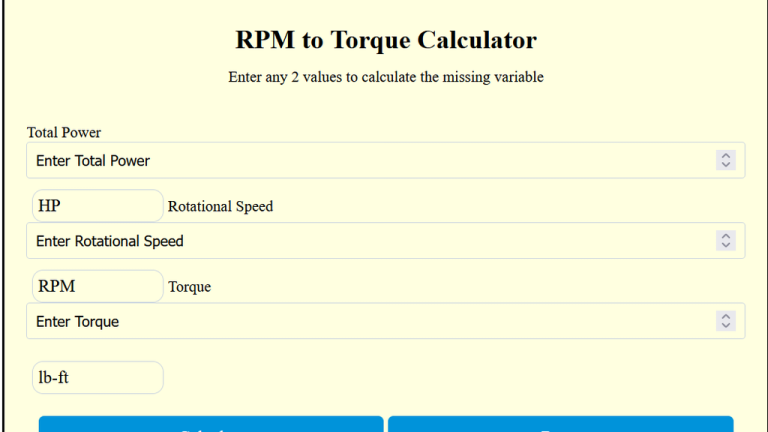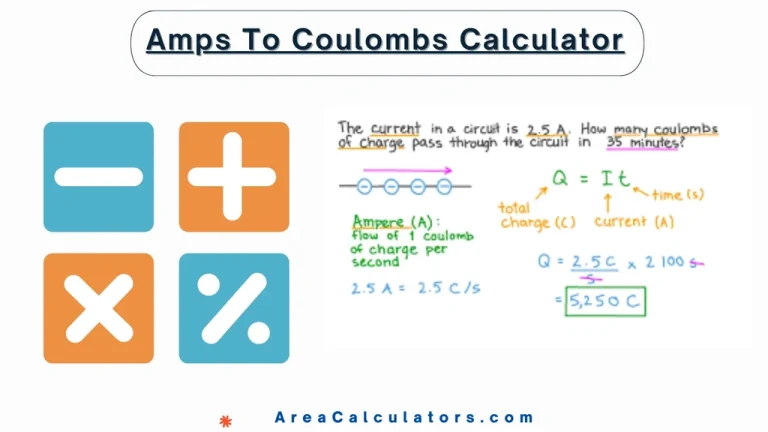Stall Converter (K-Factor) Calculator
To determine the stall converter’s K-factor, multiply the engine’s RPM by the square root of the torque (T). This value helps assess the efficiency of torque converters and engine performance.
To determine the stall converter’s K-factor, multiply the engine’s RPM by the square root of the torque (T). This value helps assess the efficiency of torque converters and engine performance.
The Stall Converter (K-Factor) Calculator is a valuable tool for evaluating the efficiency and performance of torque converters in vehicles. The K-factor indicates how well the converter matches the engine’s torque and power characteristics. It is especially useful for optimizing performance in drag racing or other high-performance scenarios.
K = RPM × √T
| Variable | Description |
|---|---|
| K | Stall converter K-factor |
| RPM | Revolutions per minute of the engine |
| T | Torque in pound-feet (ft-lb) |
Example 1: Engine with 3000 RPM and 350 ft-lb Torque
| Step | Value |
|---|---|
| Engine RPM | 3000 RPM |
| Torque (T) | 350 ft-lb |
| K-Factor | 3000 × √350 = 56,568 |
Example 2: Engine with 4000 RPM and 450 ft-lb Torque
| Step | Value |
|---|---|
| Engine RPM | 4000 RPM |
| Torque (T) | 450 ft-lb |
| K-Factor | 4000 × √450 = 84,852 |
The Stall Converter (K-Factor) Calculator is an essential tool for automotive enthusiasts and professionals. It evaluates the K-Factor of a torque converter, a value that helps determine the converter’s stall speed in relation to engine torque.
By using this calculator, users can select the appropriate stall converter for their vehicle’s specific performance requirements.
The stall speed of a torque converter is critical for optimizing acceleration, especially in high-performance or drag racing vehicles. The calculator considers key inputs like engine torque and desired RPM to calculate the ideal K-Factor.
This helps ensure the right balance between power and efficiency, avoiding issues such as insufficient power transfer or excessive slippage.
This tool is valuable for tuning vehicles, upgrading performance, or diagnosing issues with an existing torque converter. It’s also highly useful for enthusiasts looking to understand and optimize their car’s drivetrain performance.
In summary, the Stall Converter (K-Factor) Calculator empowers users to make precise adjustments to their vehicle’s performance. With accurate calculations, it simplifies the process of selecting or tuning torque converters for a seamless driving experience.

Multiply the power in horsepower by 5252.08 and divide by the RPM to calculate torque in pound-feet. The RPM to Torque Calculator converts rotational speed (RPM) and power (horsepower) into torque. Torque is the rotational force an engine or motor produces, which is crucial for evaluating mechanical performance. This tool is widely used in automotive,…
To determine the new coordinates after rotating a point around the origin, apply the rotation formulas using the angle of rotation, θ This process adjusts each coordinate based on trigonometric functions for precise new positions. In geometry, rotation of coordinates is a transformational method that repositions points or shapes around a fixed center. This rotation…

To calculate the total charge in coulombs, multiply the current in amperes (A) by the time in seconds (t). This will give you the total electric charge transferred. The Amps to Coulombs Calculator is a tool designed to convert electrical current (Amps) into electric charge (Coulombs). Coulombs represent the total electric charge passing through a…
To convert cubic feet to pounds, multiply the volume in cubic feet (CF) by the density of the substance (D) in pounds per cubic foot. Cubic Feet to Pounds Calculator Cubic Feet (ft³) Density (lbs/ft³) Pounds (lbs) Calculate Reset The Cubic Feet ↔ Pounds Calculator comes with the ability to convert volumes in cubic feet…
To determine average monthly attendance, multiply the attendance rate by the total school days in a month, then divide by 100 for the average attendance days. The Average Monthly Attendance of Students Calculator is utilized in schools, universities, and educational institutions to track attendance patterns. It is mandatory to calculate the average attendance of students…
Divide the number of immature neutrophils by the total number of neutrophils to determine the I/T ratio. The IT Ratio Calculator measures the Immature-to-Total Neutrophil Ratio (I/T Ratio), commonly used in neonatal and clinical settings to assess infection risk or sepsis. By comparing immature neutrophils to total neutrophils in a blood sample, this tool…